
The first day of the Easter Rising, Monday, 24 April 1916, saw some 1,200 volunteer soldiers of the Irish Volunteers take over positions in the centre of Dublin, launching the week-long revolution known as the Easter Rising.

The first day of the Easter Rising, Monday, 24 April 1916, saw some 1,200 volunteer soldiers of the Irish Volunteers take over positions in the centre of Dublin, launching the week-long revolution known as the Easter Rising.
The Volunteers' Dublin division was organized into four battalions. As a result of Eoin MacNeill's countermanding order all of them saw a far smaller turnout than originally planned.
The 1st battalion under Commandant Ned Daly mustered at Blackhall Street, numbering about 250 men. They were to occupy the Four Courts and areas to the northwest to guard against attack from the west, principally from the Royal and Marlborough Barracks; the exception was D Company, 1st Battalion, a company of 12 men led by Captain Seán Heuston, who were to occupy the Mendicity Institution, across the river from the Four Courts.
The 2nd battalion comprised about 200 men under Commandant Thomas MacDonagh who gathered at St. Stephen's Green with orders to take Jacob's Biscuit Factory, Bishop Street, south of the city centre, and a smaller number of men who gathered at Fairview, in the northeast, and who were directed to the General Post Office. [1]
In the southeast Commandant Éamon de Valera commanded about 130 men of the 3rd battalion who would take Boland's Bakery and a number of surrounding buildings to cover Beggars Bush Barracks and the main road and railway from Kingstown (now Dún Laoghaire) harbour.
Commandant Éamonn Ceannt's 4th battalion, numbering about 100 men, mustered at Emerald Square in Dolphin's Barn; They were to occupy the workhouse known as the South Dublin Union to the southwest and defend against attack from the Curragh. [2]

A joint force of about 400 Volunteers and Citizen Army gathered at Liberty Hall under the command of Commandant James Connolly. Of these, about 100 men and women of the Citizen Army under Commandant Michael Mallin were sent to occupy St. Stephen's Green, and a small detachment of the Citizen Army under Captain Sean Connolly were directed to seize the area around the City Hall, next to Dublin Castle, including the offices of the Daily Express . [3] The remainder was to occupy the General Post Office. This was the headquarters battalion, and as well as Connolly it included four other members of the Military Council: Patrick Pearse, provisional president and commander-in-chief, Tom Clarke, Seán Mac Dermott and Joseph Plunkett. [4]
In at least two incidents, at Jacob's [5] and Stephens Green, [6] the Volunteers and Citizen Army shot civilians who were trying to attack them or dismantle their barricades. Elsewhere, they hit civilians with their rifle butts to drive them off. [7]
At midday, a small team of Volunteers and Fianna members attacked the Magazine Fort in the Phoenix Park and disarmed the guards, with the intent to seize weapons and blow up the building as a signal that the rising had begun. They set explosives but failed to obtain any arms. The explosion was not loud enough to be heard in the city. [8] At the same time the Volunteer and Citizen Army forces throughout the city moved to occupy and secure their positions. Seán Connolly's unit made an assault on Dublin Castle, shooting dead a police sentry and overpowering the soldiers in the guardroom, but did not press home the attack.
The under-secretary, Sir Matthew Nathan, who was in his office with Colonel Ivor Price, the Military Intelligence Officer, and A. H. Norway, head of the Post Office, was alerted by the shots and helped close the castle gates. [9] The rebels occupied the Dublin City Hall and adjacent buildings. Mallin's detachment, which was joined by Constance Markievicz (Countess Markievicz), occupied St. Stephen's Green, digging trenches and commandeering vehicles to build barricades. They took several buildings, including the Royal College of Surgeons, but did not make an attempt on the Shelbourne Hotel, a tall building overlooking the park. [10]
Daly's men, erecting barricades at the Four Courts, were the first to see action. A troop of the 5th and 12th Lancers, part of the 6th Cavalry Reserve Regiment, was escorting an ammunition convoy along the north Quays when it came under fire from the rebels. Unable to break through, they took refuge in nearby buildings. [11]

The headquarters battalion, led by Connolly, marched the short distance to O'Connell Street. They charged the GPO, expelled customers and staff, and took a number of British soldiers prisoner. Two flags were hoisted on the flag poles on each end of the GPO roof: the tricolour at the right corner at Henry Street and a green flag with the inscription 'Irish Republic' at the left corner at Princess Street. A short time later, Pearse read the Proclamation of the Republic outside the GPO. [12]
The Commander-in-Chief of the British Army in Ireland, General Lovick Friend, was on leave in England. When the insurrection began the Officer Commanding the Dublin Garrison, Colonel Kennard, could not be located. His adjutant, Col. H. V. Cowan, telephoned Marlborough Barracks and asked for a detachment of troops to be sent to Sackville Street (O'Connell Street) to investigate the situation at the GPO. He then telephoned Portobello, Richmond and the Royal Barracks and ordered them to send troops to relieve Dublin Castle. Finally, he contacted the Curragh and asked for reinforcements to be sent to Dublin. [13]
A troop of the 6th Reserve Cavalry Regiment, dispatched from Marlborough Barracks, proceeded down O'Connell Street. As it passed Nelson's Pillar, level with the GPO, the rebels opened fire, killing three cavalrymen and two horses [14] and fatally wounding a fourth man. The cavalry retreated and were withdrawn to barracks. This action is often referred to, inaccurately, as the "Charge of the Lancers." [15]
A piquet from the 3rd (Reserve) Battalion, Royal Irish Regiment (RIR), approaching the city from Richmond Barracks, encountered an outpost of Éamonn Ceannt's force under Section-Commander John Joyce in Mount Brown, at the north-western corner of the South Dublin Union. A party of twenty men under Lieutenant George Malone was ordered to march on to Dublin Castle.[ citation needed ]
They proceeded a short distance with rifles sloped and unloaded before coming under fire, losing three men in the first volley, then broke into a tan-yard opposite. Malone's jaw was shattered by a bullet as he went in. The Commanding Officer, Lieutenant-Colonel R. L. Owens, brought up the remainder of his men from Richmond Barracks. A company with a Lewis gun was sent to the Royal Hospital (not then a hospital but the British military headquarters), overlooking the Union. The main body took up positions along the east and south walls of the Union, occupying houses and a block of flats, then opened fire on the rebel positions, forcing Joyce and his men to retreat across open ground. A party led by Lieut. Alan Ramsay broke open a small door next to the Rialto gate, but Ramsay was shot and killed, and the attack was repulsed. A second wave led by Capt. Warmington charged the door but Warmington, too, was killed.[ citation needed ]
The remaining troops, trying to break in further along the wall, were enfiladed from Jameson's distillery in Marrowbone Lane. Eventually, the superior numbers and firepower of the British were decisive; they forced their way inside and the small rebel force in the tin huts at the eastern end of the Union surrendered. [16]
The first fatality of the engagement was a non-combatant. A nurse, Margaret Keogh, grand-niece of Captain Myles Keogh, responded to the sound of shots. As Keough attempted to tend to the injured, she was shot dead by a British soldier. [17] [18]

The Easter Rising, also known as the Easter Rebellion, was an armed insurrection in Ireland during Easter Week in April 1916. The Rising was launched by Irish republicans against British rule in Ireland with the aim of establishing an independent Irish Republic while the United Kingdom was fighting the First World War. It was the most significant uprising in Ireland since the rebellion of 1798 and the first armed conflict of the Irish revolutionary period. Sixteen of the Rising's leaders were executed starting in May 1916. The nature of the executions, and subsequent political developments, ultimately contributed to an increase in popular support for Irish independence.

The Irish Volunteers, also known as the Irish Volunteer Force or the Irish Volunteer Army, was a paramilitary organisation established in 1913 by nationalists and republicans in Ireland. It was ostensibly formed in response to the formation of its Irish unionist/loyalist counterpart the Ulster Volunteers in 1912, and its declared primary aim was "to secure and maintain the rights and liberties common to the whole people of Ireland". Its ranks included members of the Conradh na Gaeilge, Ancient Order of Hibernians, Sinn Féin and the Irish Republican Brotherhood. Increasing rapidly to a strength of nearly 200,000 by mid-1914, it split in September of that year over John Redmond's support for the British war effort during World War I, with the smaller group opposed to Redmond's decision retaining the name "Irish Volunteers".

The Proclamation of the Republic, also known as the 1916 Proclamation or the Easter Proclamation, was a document issued by the Irish Volunteers and the Irish Citizen Army during the Easter Rising in Ireland, which began on 24 April 1916. In it, the Military Council of the Irish Republican Brotherhood, writing as the "Provisional Government of the Irish Republic," proclaimed Ireland's independence from the United Kingdom. The reading of the proclamation by Patrick Pearse outside the General Post Office (GPO) on Sackville Street, Dublin's main thoroughfare, marked the beginning of the Rising. The proclamation was modelled on a similar independence proclamation issued during the 1803 rebellion by Robert Emmet.

Thomas James Clarke was an Irish republican and a leader of the Irish Republican Brotherhood. Clarke was arguably the person most responsible for the 1916 Easter Rising. A proponent of armed struggle against British rule in Ireland for most of his life, Clarke spent 15 years in English prisons prior to his role in the Easter Rising, and was executed by firing squad after it was defeated.
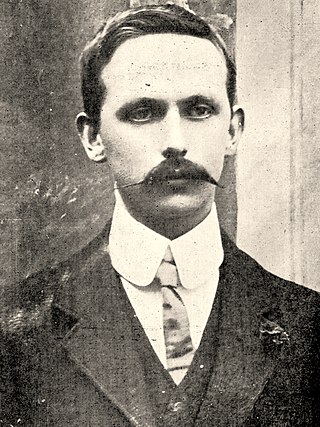
Éamonn Ceannt, born Edward Thomas Kent, was an Irish republican, mostly known for his role in the Easter Rising of 1916.
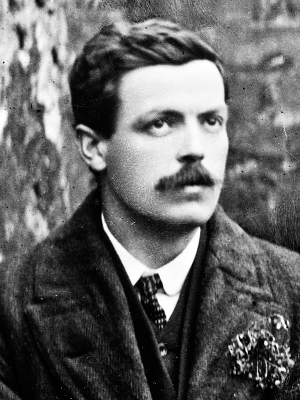
Michael O'Hanrahan was an Irish rebel who was executed for his active role in the 1916 Easter Rising.

The Irish Citizen Army, or ICA, was a small paramilitary group of trained trade union volunteers from the Irish Transport and General Workers' Union (ITGWU) established in Dublin for the defence of workers' demonstrations from the Dublin Metropolitan Police. It was formed by James Larkin, James Connolly and Jack White on 23 November 1913. Other prominent members included Seán O'Casey, Constance Markievicz, Francis Sheehy-Skeffington, P. T. Daly and Kit Poole. In 1916, it took part in the Easter Rising, an armed insurrection aimed at ending British rule in Ireland.

Thomas Patrick Ashe was a member of the Gaelic League, the Gaelic Athletic Association, the Irish Republican Brotherhood (IRB) and a founding member of the Irish Volunteers.
Events from the year 1916 in Ireland.
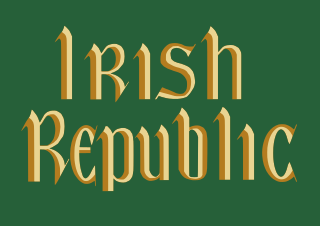
Cumann na mBan, abbreviated C na mB, is an Irish republican women's paramilitary organisation formed in Dublin on 2 April 1914, merging with and dissolving Inghinidhe na hÉireann, and in 1916, it became an auxiliary of the Irish Volunteers. Although it was otherwise an independent organisation, its executive was subordinate to that of the Irish Volunteers, and later, the Irish Republican Army.
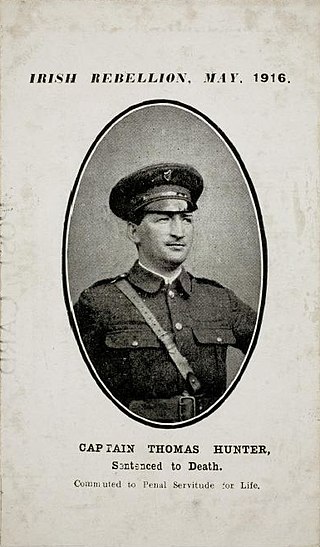
Thomas Cornelius Hunter was a militant Irish republican. He was a member of the Irish Republican Brotherhood (IRB), Sinn Féin, the Irish Volunteers, was twice elected to the Irish parliament, Dáil Éireann, and fought against the forces of the Irish Free State as a member of the Irish Republican Army during the Irish Civil War. While not widely known today, he was present at or directly involved in several major incidents during the struggle for Irish independence from the United Kingdom of Great Britain and Ireland.

Elizabeth O'Farrell was an Irish nurse, republican and member of Cumann na mBan, best known for delivering the surrender in the Easter Rising of 1916.

George Oliver Plunkett, known to his contemporaries as Seoirse Plunkett, was a militant Irish republican. He was sentenced to death with his elder brother Joseph Plunkett and his younger brother John after the 1916 Easter Rising, but while Joseph was executed, George's and John's sentences were commuted. He was released in 1917, fought in the Irish War of Independence and Irish Civil War, and was briefly IRA Chief of Staff during World War II.
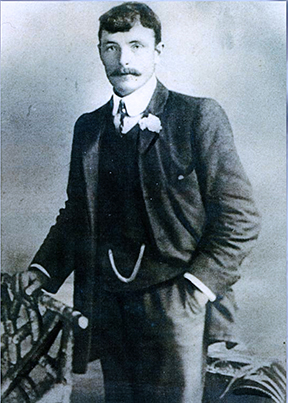
James McCormack (1877–1916) was an Irish activist & revolutionary who, as part of the Irish Citizen Army, fought and died in the Easter Rising of 1916.

Patrick Whelan was an Irish Volunteer, killed in action in Boland's Mill during the Battle of Mount Street Bridge at the time of the Easter Rising of 1916. He was 22 years old when he died and was awarded the 1916 Medal posthumously in 1941. Whelan House in Thorncastle Street, Ringsend, Dublin – where he was born – is named in his honour.

Seán McLoughlin was an Irish nationalist and communist activist. When only twenty, he was made a commandant-general during the Easter Rising. He was then prominent in Irish and British socialist parties before fighting with the Irish Republican Army during the Irish Civil War. He was also a leader in Na Fianna Éireann.

Elizabeth ‘Lily’ O'Brennan, was an Irish republican, writer and playwright.
Anna Fahy was a metal artist, Irish nationalist and republican, and member of the Cumann na mBan. She was active during the Easter Rising of 1916.
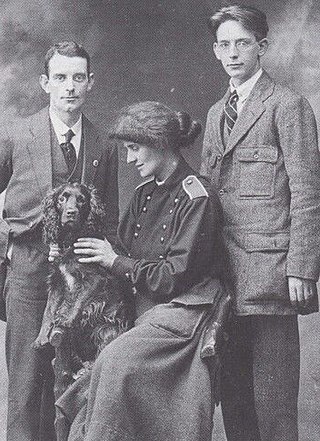
Theobald Wolfe Tone FitzGerald was an Irish army officer and painter. He is recognised for his role in painting the Irish Republic flag that flew over the General Post Office during the Easter Rising 1916. The flag was kept as a trophy by the British Army until it was returned to Ireland during the 1966 commemorations. He was the brother in-law of Lieutenant Michael Malone, who was killed in action at the Battle of Mount Street Bridge during the 1916 Rising, Seán Mac Mahon, the former General Chief of Staff, and the politician Dan Breen.
Molly O'Reilly was an Irish republican and Socialist activist and soldier, taking part in the 1916 Irish Easter Rising with the Irish Citizen Army. Most notably, she unfurled the flag at Liberty Hall for the ICA during preparations for the rising.